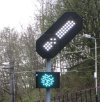Dear all,
Many years back in our original driver training (UK mainline railway) we were told that when presented with a junction route indicator arm, pre LED type with five white lights, that if two or more of the white lights in the indicator arm had failed that the route should be considered "incorrectly described" and not taken, contact the signaller and act upon the instructions given.
I cannot for the life of me find anywhere in any available publications if this was EVER was an official rule or was and has been since dropped and whether there are any such restrictions currently in place.
Can anyone shed any light on this?
For clarity:
1) Was the two or more lamps failed in the junction indicator arm to be considered "incorrectly described" a rule?
2) Is there a current rule (there's nothing in the latest RSSB rulebook) or guide in effect that relates to the number of failed indicator lamps there can be in the suction indicator before it must be considered not showing correctly?
Your input and assistance gratefully appreciated!
Many years back in our original driver training (UK mainline railway) we were told that when presented with a junction route indicator arm, pre LED type with five white lights, that if two or more of the white lights in the indicator arm had failed that the route should be considered "incorrectly described" and not taken, contact the signaller and act upon the instructions given.
I cannot for the life of me find anywhere in any available publications if this was EVER was an official rule or was and has been since dropped and whether there are any such restrictions currently in place.
Can anyone shed any light on this?
For clarity:
1) Was the two or more lamps failed in the junction indicator arm to be considered "incorrectly described" a rule?
2) Is there a current rule (there's nothing in the latest RSSB rulebook) or guide in effect that relates to the number of failed indicator lamps there can be in the suction indicator before it must be considered not showing correctly?
Your input and assistance gratefully appreciated!

